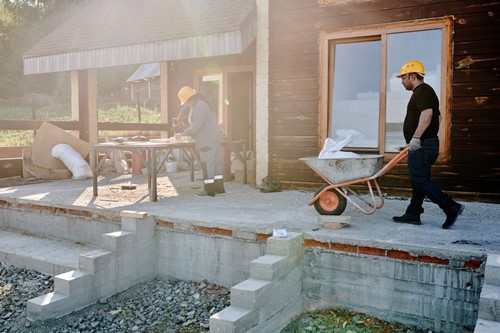
In both existing homes and new construction, there are several common types of foundations for houses. Each has their advantages and disadvantages, including specific maintenance requirements and climate-specific considerations.
Whether you’re building a new home or want to learn more about how to care for your existing home, it’s worth exploring the three major types of foundations used for houses:
Basement foundation
Basement foundations are essentially holes dug beneath the house, matching most or all of the ground-level square footage. Builders use concrete footings around the edge of the basement space as a frame for the foundation, then follow with beams, walls and a concrete slab at the bottom.
Basement foundations can add extra living space to the home, potentially doubling the square footage if finished. Otherwise, unfinished basements serve as valuable storage space and shelter in case of extreme weather.
Concrete slab foundation
Concrete slab foundations are made of a simple, flat layer of concrete situated slightly below the surface of the ground. This is one of the simplest foundation types to install, involving a wire mesh and reinforcing bars within the concrete for extra stability.
Slab foundations are best for warmer regions, as frozen ground can cause cracks and shifts in the concrete. However, in the right conditions, a slab foundation will not develop weak spots or crumble over time.
Crawl space foundation
Crawl space foundations have characteristics of both a basement and a slab foundation. They’re built using small concrete footings called stem walls, which create a slightly elevated space beneath the home. While you can’t use a crawl space as living space, it can be perfect for storage and access to plumbing or electrical wiring.
Crawl space foundations can help keep the home safe from flood damage, earthquake damage and termites. One disadvantage of this foundation type is the vulnerability to mold, mildew and pests who might like to make the shelter their home.
There are other types of foundations, like wood foundations and pier foundations, which are typically more specific to certain regions and types of home. There are also variations of the foundations found in this article, such as slab on grade foundations and daylight basements.
Regardless, the more you know about these three common types of concrete foundation, the more prepared you’ll be to take care of your own - whether in your current home or brand-new construction.
About the Author

Carol McCullough Relocation Certified
As a Fairfield resident with a family commuting daily on Metro North, and our children graduating from Fairfield public schools, I look forward to sharing many of the great attractions in a wonderful community and county! Over the past 18 years with Berkshire Hathaway Home Services New England Properties, I have helped hundreds of buyers and sellers compete their home search and close on the sale of their property. As a Certified Relocation Specialist, my production results rank in the top 4% nationally while delivering exceptional customer service to my clients and their welcomed referrals. Real Estate is one of the most exciting investments you can make. It should be a fun and rewarding experience. Confident with your home marketing decisions and comfortable with the home marketing process is my commitment to you! I am excited to share several new marketing strategies successfully implemented in Southern Fairfield County! Regardless if you are looking to buy, or about to list your current home, you will soon BE AT HOME when working with Carol! *Connecticut Magazine 2022 Award Winner- 12th consecutive year scoring highest in overall customer satisfaction.
